河北省衡水中学2018届高三仿真模拟卷(三)英语试题(有答案)
- 格式:doc
- 大小:71.50 KB
- 文档页数:13
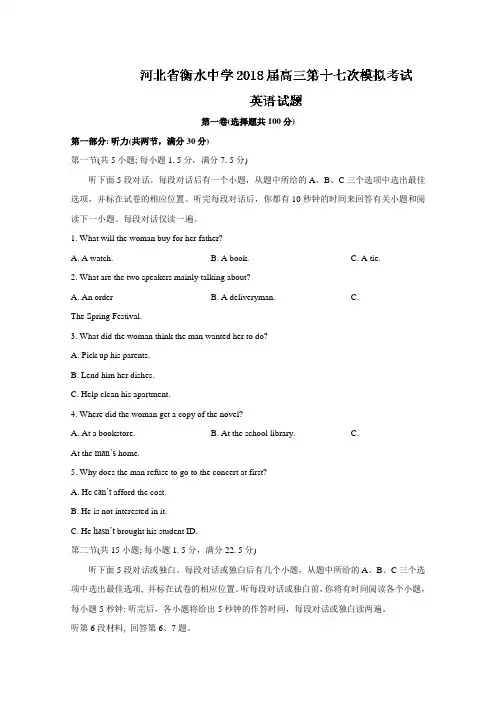
第一卷(选择题共100分)第一部分: 听力(共两节,满分30分)第一节(共5小题; 每小题1. 5分,满分7. 5分)听下面5段对话。
每段对话后有一个小题,从题中所给的A、B、C 三个选项中选出最佳选项,并标在试卷的相应位置。
听完每段对话后,你都有10秒钟的时间来回答有关小题和阅读下一小题。
每段对话仅读一遍。
1. What will the woman buy for her father?A. A watch.B. A book.C. A tie.2. What are the two speakers mainly talking about?A. An orderB. A deliveryman.C.The Spring Festival.3. What did the woman think the man wanted her to do?A. Pick up his parents.B. Lend him her dishes.C. Help clean his apartment.4. Where did the woman get a copy of the novel?A. At a bookstore.B. At the school library.C.At the man’s home.5. Why does the man refuse to go to the concert at first?A. He can’t afford the cost.B. He is not interested in it.C. He hasn’t brought his student ID.第二节(共15小题; 每小题1. 5分,满分22. 5分)听下面5段对话或独白。
每段对话或独白后有几个小题,从题中所给的A、B、C三个选项中选出最佳选项, 并标在试卷的相应位置。
听每段对话或独白前,你将有时间阅读各个小题,每小题5秒钟: 听完后,各小题将给出5秒钟的作答时间,每段对话或独白读两遍。
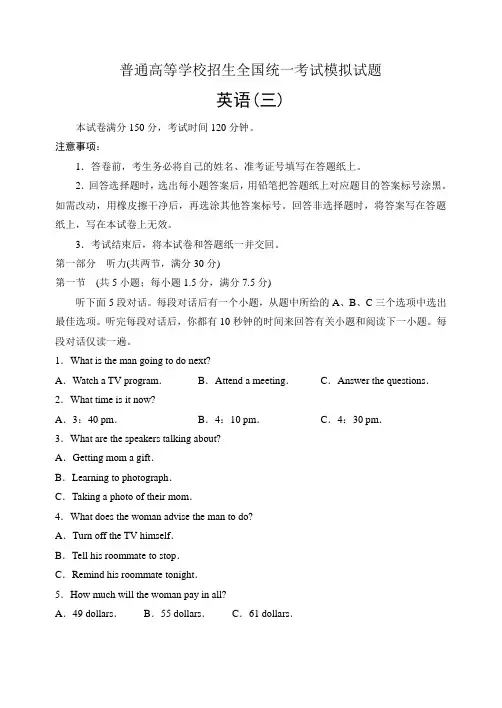
普通高等学校招生全国统一考试模拟试题英语(三)本试卷满分150分,考试时间120分钟。
注意事项:1.答卷前,考生务必将自己的姓名、准考证号填写在答题纸上。
2.回答选择题时,选出每小题答案后,用铅笔把答题纸上对应题目的答案标号涂黑。
如需改动,用橡皮擦干净后,再选涂其他答案标号。
回答非选择题时,将答案写在答题纸上,写在本试卷上无效。
3.考试结束后,将本试卷和答题纸一并交回。
第一部分听力(共两节,满分30分)第一节(共5小题;每小题1.5分,满分7.5分)听下面5段对话。
每段对话后有一个小题,从题中所给的A、B、C三个选项中选出最佳选项。
听完每段对话后,你都有10秒钟的时间来回答有关小题和阅读下一小题。
每段对话仅读一遍。
1.What is the man going to do next?A.Watch a TV program.B.Attend a meeting.C.Answer the questions.2.What time is it now?A.3:40 pm.B.4:10 pm.C.4:30 pm.3.What are the speakers talking about?A.Getting mom a gift.B.Learning to photograph.C.Taking a photo of their mom.4.What does the woman advise the man to do?A.Turn off the TV himself.B.Tell his roommate to stop.C.Remind his roommate tonight.5.How much will the woman pay in all?A.49 dollars.B.55 dollars.C.61 dollars.第二节(共15小题;每小题1.5分,满分22.5分)听下面5段对话或独白。
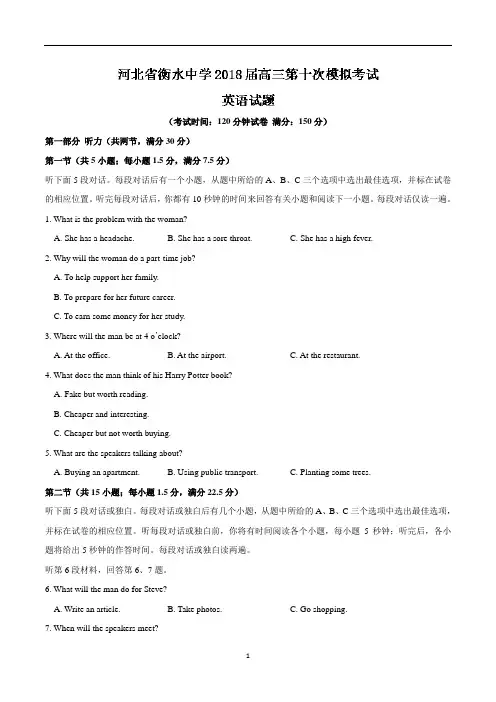
(考试时间:120分钟试卷满分:150分)第一部分听力(共两节,满分30分)第一节(共5小题;每小题1.5分,满分7.5分)听下面5段对话。
每段对话后有一个小题,从题中所给的A、B、C三个选项中选出最佳选项,并标在试卷的相应位置。
听完每段对话后,你都有10秒钟的时间来回答有关小题和阅读下一小题。
每段对话仅读一遍。
1. What is the problem with the woman?A. She has a headache.B. She has a sore throat.C. She has a high fever.2. Why will the woman do a part-time job?A. To help support her family.B. To prepare for her future career.C. To earn some money for her study.3. Where will the man be at 4 o’clock?A. At the office.B. At the airport.C. At the restaurant.4. What does the man think of his Harry Potter book?A. Fake but worth reading.B. Cheaper and interesting.C. Cheaper but not worth buying.5. What are the speakers talking about?A. Buying an apartment.B. Using public transport.C. Planting some trees.第二节(共15小题;每小题1.5分,满分22.5分)听下面5段对话或独白。
每段对话或独白后有几个小题,从题中所给的A、B、C三个选项中选出最佳选项,并标在试卷的相应位置。
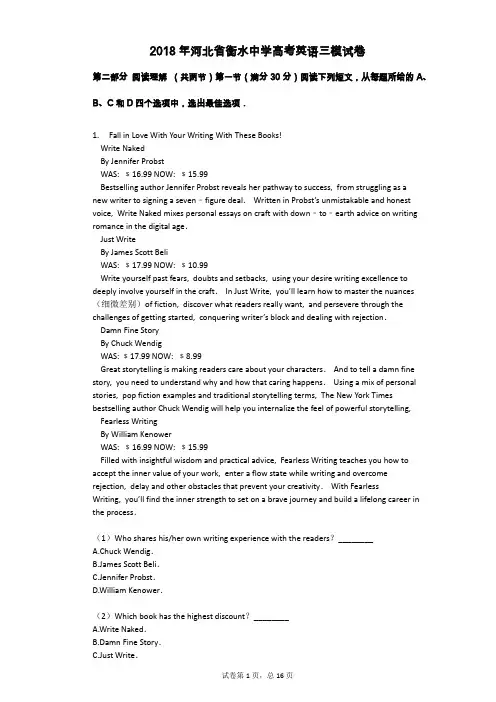
2018年河北省衡水中学高考英语三模试卷第二部分阅读理解(共两节)第一节(满分30分)阅读下列短文,从每题所给的A、B、C和D四个选项中,选出最佳选项.1. Fall in Love With Your Writing With These Books!Write NakedBy Jennifer ProbstWAS: ﹩16.99 NOW: ﹩15.99Bestselling author Jennifer Probst reveals her pathway to success, from struggling as anew writer to signing a seven﹣figure deal.Written in Probst’s unmistakable and honest voice, Write Naked mixes personal essays on craft with down﹣to﹣earth advice on writing romance in the digital age.Just WriteBy James Scott BeliWAS: ﹩17.99 NOW: ﹩10.99Write yourself past fears, doubts and setbacks, using your desire writing excellence to deeply involve yourself in the craft. In Just Write, you’ll learn how to master the nuances (细微差别)of fiction, discover what readers really want, and persevere through the challenges of getting started, conquering writer’s block and dealing with rejection.Damn Fine StoryBy Chuck WendigWAS: ﹩17.99 NOW: ﹩8.99Great storytelling is making readers care about your characters. And to tell a damn fine story, you need to understand why and how that caring happens. Using a mix of personal stories, pop fiction examples and traditional storytelling terms, The New York Times bestselling author Chuck Wendig will help you internalize the feel of powerful storytelling,Fearless WritingBy William KenowerWAS: ﹩16.99 NOW: ﹩15.99Filled with insightful wisdom and practical advice, Fearless Writing teaches you how to accept the inner value of your work, enter a flow state while writing and overcome rejection, delay and other obstacles that prevent your creativity. With FearlessWriting, you’ll find the inner strength to set on a br ave journey and build a lifelong career in the process.(1)Who shares his/her own writing experience with the readers?________A.Chuck Wendig.B.James Scott Beli.C.Jennifer Probst.D.William Kenower.(2)Which book has the highest discount?________A.Write Naked.B.Damn Fine Story.C.Just Write.D.Fearless Writing.(3)What do the tour books have in common?________A.They are written by bestselling authors.B.They show how to overcome rejection.C.They give some practical advice on writing.D.They focus on traditional storytelling terms.【答案】CBC【考点】完形综合阅读理解综合【解析】本文是广告布告类阅读,介绍了关于写作的四本书,对写作给与了实际的建议,介绍了书名,作者,优惠价格及书中内容简介.【解答】(1) C.细节题.根据文章内容,Bestselling author Jennifer Probst reveals her pathway to success, from struggling as a new writer to signing a seven﹣figure deal.由此可知,畅销书作家Jennifer Probst 将她的成名之路与广大的读者分享了,从一个没有经验的写作人到知名的作家的过程都进行了描述.结合选项,故选C.(2)B.数字计算题,根据题干要可知,问的是哪本书的折扣最大,Write Naked:WAS:﹩16.99 NOW:﹩15.99,优惠1美元;Damn Fine Story:WAS:﹩17.99 NOW:﹩8.99,优惠9美元;Just Write:WAS:﹩17.99 NOW:﹩10.99,优惠7美元;Fearless Writing:WAS:﹩16.99 NOW:﹩15.99,优惠1美元;综上可知,Damn Fine Story优惠最大,故答案为B.(3)C.总结归纳题.根据标题Fall in Love With Your Writing With These Books!可知这四本书是关于写作的,所以共同之处在于对写作给与了实际的建议,故答案为C.2. The year 2117 will be an eventful one for art. In May of that year in Berlin, the philosopher﹣artist Jonathon Keats’ “century cameras”﹣ cameras with a 100﹣year﹣long exposure (曝光)time﹣will be brought back from hiding places around the city to have their results developed and exhibited. Six months after that, the Future Library inOslo, Norway, will open its doors for the first time, presenting 100books printed on the wood of trees planted in the distant past of 2017.As Katie Paterson, the creator of the Future Library, puts it: “Future Library is an artwork for future generations.” These projects, more than a century in the making, are part of a new wave of slow art intended to push viewers and Participants to think beyond their own lifetimes.They aim to challenge today’s short﹣term thinking and the brief attention spans of modern consumers, forcing people into considering works more deliberately. In their way, too, they are fighting against modern culture﹣not just regarding money, but also the way in which artistic worth is measured by attention.In a similar fashion, every April on Slow Art Day, visitors are encouraged to stare at five works of art for 10 minutes at a time﹣a tough task for the average museum visitor, who typically spends less than30seconds on each piece of art.Like the Future Library, the century cameras are very much a project for cities, since it’s in cities that time runs fastest and the pace of life is fastest.“Since I started living in acity, I’ve somehow been quite disconnected,” Anne Beate Hovind, the Future Library project manager, who described how working on the library drew her back to the Pace oflife she knew when she was growing up on a farm in her youth, told The Atlantic magazine.(1)According to the first paragraph, what will NOT happenin2117?________A.A camera which was produced 100 years ago will be exhibited.B.The Future Library will be o pen to the public for the first time.C.Photos with a 100﹣year exposure time will be developed and exhibited.D.Books printed on the wood of trees planted in 2017 will be displayed.(2)What can we learn about today’s people’s attitude toward works of art?________A.They consider works deliberately.B.They spend little time on Works.C.They spend much money on works.D.They stare at works for 10 minutes at a time.(3)What is the purpose of the wave of slow art?________A.To advocate creating works of art slowly.B.To protect works of art from being damaged.C.To promote works of art for modern culture.D.To encourage people to pay more attention to works of art.(4)How would Anne Beate Hovind feel about the city life?________A.It’s discouraging.B.It’s dull.C.Its developed.D.It’s busy.【答案】ABDD【考点】阅读理解综合【解析】本文是一篇科教类阅读,文章主要讲述了城市生活太忙碌了.人们很少花时间在欣赏艺术品上.所以慢艺术浪潮的目的是鼓励人们更多地关注艺术作品.【解答】(1)A.细节理解题.根据“The year 2117 will be an eventful one for art. In May of that year in Berlin, the philosopher﹣artist Jonathon K eats’ ”century cameras“﹣ cameras witha 100﹣year﹣long exposure (曝光)time﹣will be brought back from hiding places around the city to have their results developed and exhibited”可知根据第一段可知,展出的是相机拍摄的内容,而不是相机本身.故选A.(2)B.细节理解题.根据“In a similar fashion, every April on Slow Art Day, visitorsare encouraged to stare at five works of art for 10 minutes at a time﹣a tough task for the average museum visitor,who typically spends less than30seconds on each piece of art”可知,我们能从今天的人们对艺术作品的态度中了解到,他们很少花时间在欣赏艺术品上.故选B.(3)D.推理判断题.根据“visitors are encouraged to stare at five works of art for 10 minutes at a time”可知,慢艺术浪潮的目的是鼓励人们更多地关注艺术作品.故选D.(4)D.推理判断题.根据“Like the Future Library, the century cameras are very mucha project for cities,since it’s in cities that time runs fastest and the pace of life is fastest.”Since I started living in a city"可知.安妮觉得城市生活太忙碌了.故选D.3. Scientists have been studying how people use money for long.Now they’re finding some theories may apply to one group of monkeys.Researchers recently taught six monkeys how to use money. They gave the monkeys small metal disks(圆片) that could be used like cash and showed them some yummy apple pieces. The monkeys soon figured out that if they gave one of the disks to a scientist, they d receive a piece of apple in return.If you think that is all the monkeys can figure out, you are wrong. Two researchers, Jake and Allison, acted as apple sellers in the experiments. The monkeys were tested one at a time and had 12 disks to spend in each experiment. Jake always showed the monkeys one apple piece, while Allison always showed two pieces.But that’s not necessarily what they gave the monkeys. The number of apple pieces given for a disk was determined at random. Experiment One: Allison showed two pieces of apples but gave both pieces only half the time. The other half, she took one piece away and gave the monkey just the remaining piece. Jake, on the other hand, always gave exactly what he showed: one piece for each disk. The monkeys chose to trade more with Allison.Experiment Two: Allison continued to sometimes gave two pieces and sometimes one piece. But now, half the time, Jake gave the one apple piece he was showing, and half the time he added ________.Guess what? The monkeys chose to trade more with Jake.In the first experiment, the monkeys correctly figured out that if they traded with Allison, they’d end up with more treats. In the second one, when a monkey received two pieces from Jake, it seemed like again. When Allison gave the monkey only one piece instead of the two she showed, it seemed like a loss. The monkeys preferred trading with Jake because they’d rather take a chance of seeming to win than seeming to lose.We also sometimes make silly business decisions just t o avoid the feeling that we’re getting less, even when were not. Would you have made the same choices?(1)What conclusion might experts draw from the first experiment?________A.The monkeys show certain business sense.B.Business theories can apply to all monkeys.C.People are smarter in terms of finance.D.It’s easy to teach monkeys how to trade.(2)What does a bonus in paragraph 5refer to?________A.A metal disk.B.An apple piece.C.A chance.D.A coin.(3)Why did the monkeys choose to trade more with Jake in the second experiment?________A.Because Jake always gave them two apple pieces.B.Because the apple pieces from Jake were yummy.C.Because they didn’t like the feeling of losing.D.Because they get more apple pieces from Jake.(4)What could be the best title for the passage?________A.People’s Business Decision: Lose or Gain?.B.Moneky’s Business Sense: Smart or Silly?.C.Shopping for Bargain: Same or different?.D.Disk for Apple: Who to Trade with?.【答案】ABCB【考点】阅读理解综合【解析】本文属于说明文阅读,作者通过这篇文章主要向我们描述了科学家们一直在研究人们如何使用金钱.现在他们发现一些理论可能适用于一群猴子.【解答】(1)A.细节理解题.根据文章Jake, on the other hand, always gave exactly what he showed: one piece for each disk. The monkeys chose to trade more with Allison可知专家们可以从第一次实验中得出猴子们表现出一定的商业头脑;故选A.(2)B.细节理解题.根据文章 But now, half the time, Jake gave the one apple piece he was showing, and half the time he added a bonus可知但现在,有一半时间,杰克给了他展示的一片苹果,还有一半的时间他增加了奖金;意为一片苹果;故选B.(3)C.细节理解题.根据文章The monkeys preferred trading with Jake because they’d rather take a chance of seeming to win than seeming to lose可知猴子在第二次实验中选择与杰克进行更多的交易因为他们不喜欢失败的感觉;故选C.(4)B.细节理解题.根据文章We also sometimes make silly business decisions just to avoid the feeling that we’re getting less,even when we’re not. Would you have made the same choices?可知文章的最佳标题是猴子的商业意识:聪明还是愚蠢?;故选B4. Science is finally beginning to embrace animals who were, for a long time, considered second﹣class citizens.As Annie Potts of Canterbury University has noted, chickens distinguish among one hundred chicken faces and recognize familiar individuals even after months of separation. When given problems to solve, they reason: hens trained to pick colored buttons sometimes choose to give up an immediate food reward for a slightly later (and better) one. Healthy hens may aid friends, and mourn when those friend die.Pigs respond meaningful to human symbols. When a research team led by Candace Croney at Penn State University carried wooden blocks marked with X and O symbols around pigs, only the O carriers offered food to the animals. The pigs soon ignored the X carriers in favor of the O’s. Then the team switched from real﹣life objects to T﹣shirts printed with X or O symbols. Still, the pigs walked only toward the O﹣shirted people: they had transferred their knowledge to a two﹣dimensional format, a not inconsiderable feat of reasoning.I’ve been guilty of prejudiced expectations, myself. At the start of my career almost four decades ago, I was firmly convinced that monkeys and apes out﹣think and out﹣feel otheranimals.They’re other primates(灵长目动物), after all, animals from our own mammalian(灵长目动物) class. Fairly soon, I came to see that along with our closest living relatives, whales too are masters of cultural learning. and elephants express profound joy and mourning with their social companions. Long﹣term studies in the wild on these mammals helped to fuel a viewpoint shift in our society: the public no longer so easily accepts monkeys made to undergo painful procedure in laboratories, elephants forced to perform in circuses, and dolphins kept in small tanks at theme parks.Over time, though, as I began to broaden out even further and explore the inner lives of fish, chickens, pigs, goats, and cows, 1started to wonder: Will the new science of “food animals” bring an ethical (伦理的) revolution in terms of who we eat? In other words, will our ethics start to catch up with the development of our science?Animal activists are already there, of course, committed to not eating these animals. But what about the rest of us? Can paying attention to the thinking and feeling of these animals lead us to make changes in who we eat?(1)According to Annie Potts, hens have the ability of________.A.interaction.B.analysis.C.creation.D.abstraction.(2)The research into pigs shows that pigs________.A.learn letters quickly.B.have a good eyesight.C.can build up a good relationship.D.can apply knowledge to new situations.(3)Paragraph 4is mainly about________.A.the similarities between mammals and humans.B.the necessity of long﹣term studies on mammals.C.a change in people’s attitudes towards animals.D.a discovery of how animals express themselves.(4)What might be the best title for the passage?________A.The Inner Lives of Food Animals.B.The Lifestyles of Food Animals.C.Science Reports on Food Animals.D.A Revolution in Food Animals.【答案】BDCA【考点】阅读理解综合【解析】本文是一篇科教类阅读,文章主要介绍了被我们作为食物的那些动物的内在思想.【解答】(1)B.细节理解题.根据chickens distinguish among one hundred chicken faces and recognize familiar individuals even after months of separation. When given problems tosolve可知.母鸡有分析能力.故选B.(2)D.细节理解题.根据Still, the pigs walked only toward the O﹣shirted people:they had transferred their knowledge to a two﹣dimensional format, a not inconsiderable feat of reasoning.可知,对猪的研究表明,猪可以将知识应用于新的情况.故选D.(3)C.段落大意题.根据 Long﹣term studies in the wild on these mammals helped to fuel a viewpoint shift in our society: the public no longer so easily accepts monkeys madeto undergo painful procedure kin laboratories, elephants forced to perform in circuses,and dolphins kept in small tanks at theme parks.可知,第4段主要是关于人们对动物态度的变化.故选C.(4)A.主旨大意题.阅读全文,根据文章内容可知,本文主要讲述了被我们作为食物的那些动物的内在思想.第二节(满分10分)根据短文内容,从短文后的选项中选出能填入空白处的最佳选项.选项中有两项为多余选项.A memorable science projectIf someone tells you to remember a phone number or address, it feels like an easy task at first. You repeat the numbers to yourself, either aloud or in your mind. But after just a few seconds you might find yourself starting to doubt your own memory.(1)_______ Thus, it will try to throw away information that seems old or irrelevant. There are ways of helping our minds retain (记住) information, however, and in this activity you will explore ways that we lose and keep memories.Short﹣term, or working memory,is a way of describing most people’s abilities to stor e a small amount of information for a brief period of time in a readily accessible form (2)_______People don’t have to stop and think to remember something in short term memory.(3)_______Such techniques include visualizing (观察) the information in a surprising way or linking pieces of information together so that one reminds you of the other. In the case of visualizing information, this could be as simple as remembering you parked yourcar on the fifth floor in the D section by picturing five dogs sitting in your car! (4)_______If you need to purchase cereal (谷物), milk, fruit,cheese and eggs, you could imagine the cereal in a bowl, with milk pouring over it and pieces of fruit ontop. Then imagine cracking an egg over everything,and it’s full of melted chee se! These may seem simple or even silly.(5)_______ In this activity you’ll test the recall of a few friends or family members, and learn a few tricks for improving memory!A. There are many techniques for improving memory.B. Our brain is always seeking new and useful information.C. Short﹣term memory has a short duration but is quickly and easily accessed.D. In addition, linking information could help you remember your grocery list.E. Retaining that information over longer periods of time becomes difficult yet.F. Your short﹣term memory has a limited amount of space to store information.G. However, they are proved to be good ways for improving memory by scientist.【答案】B,C,A,D,G【考点】说明文七选五【解析】本文是一篇选句填空,文章主要介绍了如果有人告诉你记住一个电话号码或地址,一开始感觉很简单.你可以大声地或在心里重复这些数字.但几秒钟后,你可能会发现自己开始怀疑自己的记忆力,我们的大脑总是在寻找新的和有用的信息.因此,它会试图抛弃那些看起来陈旧或不相关的信息.有很多方法帮助我们的思想保留(记住)的信息,然而,在这个活动中你会探索,我们失去了和保持记忆.【解答】1﹣5 BCADG(1)B.细节理解题.根据“Thus, it will try to throw away information that seems old or irrelevant因此,它会试图抛弃那些看起来陈旧或不相关的信息”可知此处应填“我们的大脑总是在寻找新的和有用的信息.”.故选B.(2)C.细节理解题.根据“People don’t have to stop and think to remember something in short term memory.人们不需要停下来思考去记住短期记忆中的东西”可知此处应填“短期记忆的持续时间很短,但访问速度很快,也很容易.”.故选C.(3)A.推理判断题.根据“Such techniques include visualizing the information in a surprising way or linking pieces of information together so that one reminds you of the other.这些技术包括以一种令人惊讶的方式将信息可视化,或者将信息片段连接在一起,这样就能让你想起另一个.”可知此处应填“有许多技术可以提高记忆力.”.故选A.(4)D.推理判断题.根据“this could be as simple as remembering you parked your car on the fifth floor in the D section by picturing five dogs sitting in your car这很简单,只要记住你把车停在D区的五楼,想象一下你车里有五只狗”可知此处应填“此外,链接信息可以帮助你记住你的购物清单.”.故选D.(5)G.推理判断题.根据“In this activity you’ll test the recall of a few friends or family members, and learn a few tricks for improving memory在这个活动中,你将测试几个朋友或家人的记忆力,并学习一些提高记忆力的技巧”可知此处应填“然而,科学家们证明它们是改善记忆力的好方法.”.故选G.第三部分语言知识运用(共两节)第一节完形填空(共 20小题;每小题1. 5分,满分30分)阅读下面短文,从短文后各题所给的A、B、C和D四个选项中,选出可以填入空白处的最佳选项,并在答题卡,上将该项涂黑.“How dare you!” My anger finally burst out when my son (1)_______ to go to the piano classes for the third time that day. He rolled his eyes at me, which made me even (2)_______. I completely lost my(3)_______and screamed at the top of my lungs, “Enough! You are not my boy anymore!” He didn’t (4)_______ or talk back to me. He responded in(5)_______with a look of helplessness that I had never seen before. He used to cry violently and beg me to(6)_______him. The innocence shining in his big eyes would(7)_______that hot﹣tempered beast in me away in the end.(8)_______.this time…Did what he had done really make me(9)_______? No. Did such anger come entirely from his improper(10)_______? No. Had I ever given it a chance to listen to and(11)_______him? No. My demanding job, my(12)_______housework, my kid’s cry for company…, all formed a minefield(雷区)and all that was needed to(13)_______it up was a fuse(导火索). My son was the(14)_______.The rest of the day, he (15)_______an outdoor walk, a ride in the park and even his favorite games and just wanted to be alone. I could (16)_______the greatest sorrowand the most true innocence in his eyes. After admitting my own fault, I held this tiny trembling creature (17)_______in my arms, tears swelling in my eyes.For those who believe "Sticks and stones may break the bone, but(18)_______can never hurt anyone", I have a piece of heartfelt advice. Do not try this most powerful weapon(19)_______the people you love. It is (20)_______enough to cut the deepest into a soul.(1)A.refusedB.requestedC.decidedD.demanded(2)A.calmerB.emptierC.happierD.angrier(3)A.breathB.weightC.temperD.thought(4)A.cryB.shoutC.smileD.respond(5)A.doubtB.reliefC.silenceD.surprise(6)A.pardonB.praiseC.abandonD.accompany(7)A.putB.giveC.throwD.drive(8)A.OtherwiseB.HoweverC.ThereforeD.Moreover(9)A.satisfiedB.puzzledC.movedD.annoyed(10)A.adviceB.behaviorC.wordsD.argument(11)A.hugB.blameC.forgiveD.understand(12)A.endlessB.enoughC.importantD.meaningful(13)A.putB.blowC.heatD.bum(14)A.choiceB.answerC.victimD.disaster(15)A.declinedB.sharedC.enjoyedD.accepted(16)A.retellB.forgetC.readD.forecast(17)A.rudelyB.firmlyC.looselyD.casually(18)A.voiceB.wordsC.forceD.feelings(19)A.forB.withC.beyondD.against(20)A.hardB.softC.sharpD.smooth【答案】ADCACADBDBDABCACBBDC【考点】完形综合【解析】作者的儿子不愿意去上钢琴班,作者非常生气,说了一些气话,让两人的关系紧张,作者的姐姐为了缓解他们的关系,让孩子去她那里,作者反思自己没有妥善处理和孩子的关系,不应该用语言伤害孩子.【解答】(1)A.考查动词及语境理解.A. refused拒绝; B. requested要求; C. decided 决定;D. demanded 要求;根据前文How dare you!" My anger finally burst out 可知作者的儿子拒绝去钢琴班让作者很生气,故答案为A.(2)D.考查形容词及语境理解.根据前文My anger finally burst out 及even一词可知儿子向作者翻白眼让他更是生气,故答案为D.(3)C.考查名词及语境理解.根据下文at the top of my lungs,“Enough! You are not my boy anymore!”可知作者彻底是发火了,故答案为C.(4)A.考查动词及语境理解.根据下文He used to cry violently 可知这次儿子没有哭也没有说话,故答案为A.(5)C.考查名词及语境理解.根据下文He used to cry violently and beg me 可知儿子这次是用沉默来作出回应,眼中充满了绝望,故答案为C.(6)A.考查动词及语境理解.A. pardon 原谅;B. praise称赞; C. abandon 放弃;D. accompany 陪伴;根据下文hot﹣tempered beast in me away in the end可知以前儿子会哭泣并乞求作者原谅,故答案为A.(7)D.考查动词及语境理解.根据The innocence shining in his big eyes would(7)that hot﹣tempered beast in me away in the end可知在他大眼睛里闪耀着的天真,最终会把作者心中那只暴躁的野兽赶走,故答案为D.(8)B.考查副词及语境理解.根据前文及(8).this time…可知然而,这一次,儿子没有那样做,而是沉默对待,前后为转折关系,故答案为B.(9)D.考查形容词及语境理解.根据Did what he had done really make me(9)?No.可知儿子做的事情确实让自己气恼了了吗,答案是不,故答案为D.(10)B.考查名词及语境理解.根据Did such anger come entirely from his improper (10)可知作者的愤怒是来自孩子不当的行为吗,故答案为B.(11)D.考查动词及语境理解.根据Had I ever given it a chance to listen to and(11)him可知作者没有给儿子机会去解释,自己也没有去理解孩子,故答案为D.(12)A.考查形容词及语境理解.根据My demanding job, my(12)housework,my kid’s cry for company…可知作者非常忙碌,那么此处是做不完的家务,故答案为A.(13)B.考查动词及语境理解.根据all formed a minefield(雷区)and all that was needed to(13)it up was a fuse可知所有这些都形成了一个雷区,而炸毁它所需要的只是一根引信,故答案为B.(14)C.考查名词及语境理解.根据前文all formed a minefield(雷区)可知儿子成了受害者,故答案为C.(15)A.考查动词及语境理解.根据下文an outdoor walk, a ride in the park and even his favorite games and just wanted to be alone可知儿子拒绝了散步,骑车甚至是游戏,故答案为A.(16)C.考查动词及语境理解.根据下文the greatest sorrow and the most true innocence in his eyes可知我能读懂他眼中最大的悲伤和最真实的天真,故答案为C.(17)B.考查副词及语境理解.A. rudely粗鲁地; B. firmly结实地; C. loosely松散地; D. casually 随意地;根据After admitting my own fault, I held this tiny trembling creature (17)in my arms可知承认了自己的过错后,作者把这个颤抖的小东西紧紧地抱在怀里,故答案为B.(18)B.考查名词及语境理解.根据Sticks and stones may break the bone, but(18)can never hurt anyone可知,树枝和石头可以折断骨头,但言语绝不能伤人,故答案为B.(19)D.考查介词及语境理解.根据 Do not try this most powerful weapon(19)the people you love可知永远不要将这个武器用于你爱的人身上,故答案为D.(20)C.考查形容词及语境理解.根据It is (20)enough to cut the deepest into a soul 可知可知它很锋利,这会刺入灵魂深处,故答案为C.第二节(每小题1. 5分,满分15分)阅读下面材料,在空白处填入适当的内容(1个单词)或括号内单词的正确形式.阅读下面短文,在空白处填入1个适当的单词或括号内单词的正确形式。
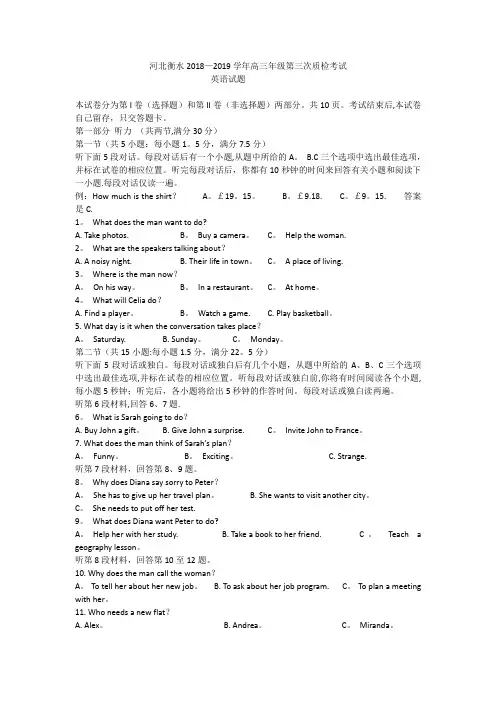
河北衡水2018—2019学年高三年级第三次质检考试英语试题本试卷分为第I卷(选择题)和第II卷(非选择题)两部分。
共10页。
考试结束后,本试卷自己留存,只交答题卡。
第一部分听力(共两节,满分30分)第一节(共5小题:每小题1。
5分,满分7.5分)听下面5段对话。
每段对话后有一个小题,从题中所给的A。
B.C三个选项中选出最佳选项,并标在试卷的相应位置。
听完每段对话后,你都有10秒钟的时间来回答有关小题和阅读下一小题.每段对话仅读一遍。
例:How much is the shirt?A。
£19。
15。
B。
£9.18. C。
£9。
15. 答案是C.1。
What does the man want to do?A. Take photos. B。
Buy a camera。
C。
Help the woman.2。
What are the speakers talking about?A. A noisy night.B. Their life in town。
C。
A place of living.3。
Where is the man now?A。
On his way。
B。
In a restaurant。
C。
At home。
4。
What will Celia do?A. Find a player。
B。
Watch a game. C. Play basketball。
5. What day is it when the conversation takes place?A。
Saturday. B. Sunday。
C。
Monday。
第二节(共15小题:每小题1.5分,满分22。
5分)听下面5段对话或独白。
每段对话或独白后有几个小题,从题中所给的A、B、C三个选项中选出最佳选项,并标在试卷的相应位置。
听每段对话或独白前,你将有时间阅读各个小题,每小题5秒钟;听完后,各小题将给出5秒钟的作答时间。
每段对话或独白读两遍。
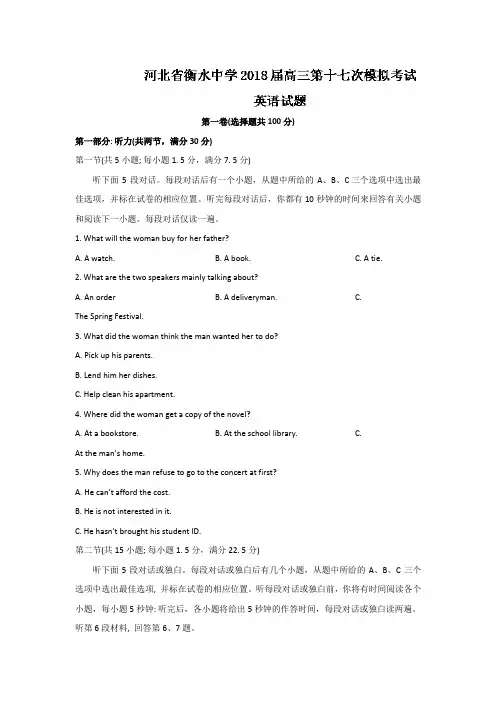
第一卷(选择题共100分)第一部分: 听力(共两节,满分30分)第一节(共5小题; 每小题1. 5分,满分7. 5分)听下面5段对话。
每段对话后有一个小题,从题中所给的A、B、C 三个选项中选出最佳选项,并标在试卷的相应位置。
听完每段对话后,你都有10秒钟的时间来回答有关小题和阅读下一小题。
每段对话仅读一遍。
1. What will the woman buy for her father?A. A watch.B. A book.C. A tie.2. What are the two speakers mainly talking about?A. An orderB. A deliveryman.C.The Spring Festival.3. What did the woman think the man wanted her to do?A. Pick up his parents.B. Lend him her dishes.C. Help clean his apartment.4. Where did the woman get a copy of the novel?A. At a bookstore.B. At the school library.C.At the man’s home.5. Why does the man refuse to go to the concert at first?A. He can’t afford the cost.B. He is not interested in it.C. He hasn’t brought his student ID.第二节(共15小题; 每小题1. 5分,满分22. 5分)听下面5段对话或独白。
每段对话或独白后有几个小题,从题中所给的A、B、C三个选项中选出最佳选项, 并标在试卷的相应位置。
听每段对话或独白前,你将有时间阅读各个小题,每小题5秒钟: 听完后,各小题将给出5秒钟的作答时间,每段对话或独白读两遍。
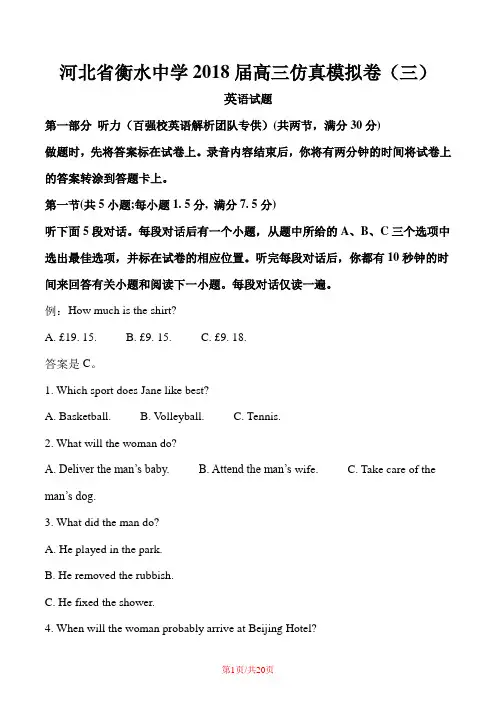
河北省衡水中学2018届高三仿真模拟卷(三)英语试题第一部分听力(百强校英语解析团队专供)(共两节,满分30分)做题时,先将答案标在试卷上。
录音内容结束后,你将有两分钟的时间将试卷上的答案转涂到答题卡上。
第一节(共5小题;每小题1. 5分, 满分7. 5分)听下面5段对话。
每段对话后有一个小题,从题中所给的A、B、C三个选项中选出最佳选项,并标在试卷的相应位置。
听完每段对话后,你都有10秒钟的时间来回答有关小题和阅读下一小题。
每段对话仅读一遍。
例:How much is the shirt?A. £19. 15.B. £9. 15.C. £9. 18.答案是C。
1. Which sport does Jane like best?A. Basketball.B. V olleyball.C. Tennis.2. What will the woman do?A. Deliver the man’s baby.B. Attend the man’s wife.C. Take care of the man’s dog.3. What did the man do?A. He played in the park.B. He removed the rubbish.C. He fixed the shower.4. When will the woman probably arrive at Beijing Hotel?A. 11:30.B. 11:50.C. 11:20.5. What are the two speakers mainly talking about?A. What to buy as birthday gifts.B. Whether to hold a birthday party.C. Where to spend the weekend.第二节(共I5小题;每小题1. 5分,满分22. 5 分)请听下面5段对话或独白。
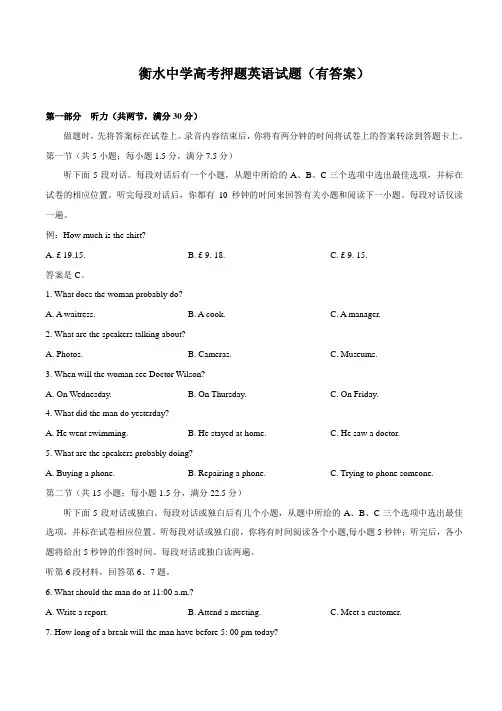
衡水中学高考押题英语试题(有答案)第一部分听力(共两节,满分30分)做题时,先将答案标在试卷上。
录音内容结束后,你将有两分钟的时间将试卷上的答案转涂到答题卡上。
第一节(共5小题;每小题1.5分,满分7.5分)听下面5段对话。
每段对话后有一个小题,从题中所给的A、B、C三个选项中选出最佳选项,并标在试卷的相应位置。
听完每段对话后,你都有10秒钟的时间来回答有关小题和阅读下一小题。
每段对话仅读一遍。
例:How much is the shirt?A. £ 19.15.B. £ 9. 18.C. £ 9. 15.答案是C。
1. What does the woman probably do?A. A waitress.B. A cook.C. A manager.2. What are the speakers talking about?A. Photos.B. Cameras.C. Museums.3. When will the woman see Doctor Wilson?A. On Wednesday.B. On Thursday.C. On Friday.4. What did the man do yesterday?A. He went swimming.B. He stayed at home.C. He saw a doctor.5. What are the speakers probably doing?A. Buying a phone.B. Repairing a phone.C. Trying to phone someone.第二节(共15小题;每小题1.5分,满分22.5分)听下面5段对话或独白。
每段对话或独白后有几个小题,从题中所给的A、B、C三个选项中选出最佳选项,并标在试卷相应位置。
听每段对话或独白前,你将有时间阅读各个小题,每小题5秒钟;听完后,各小题将给出5秒钟的作答时间。
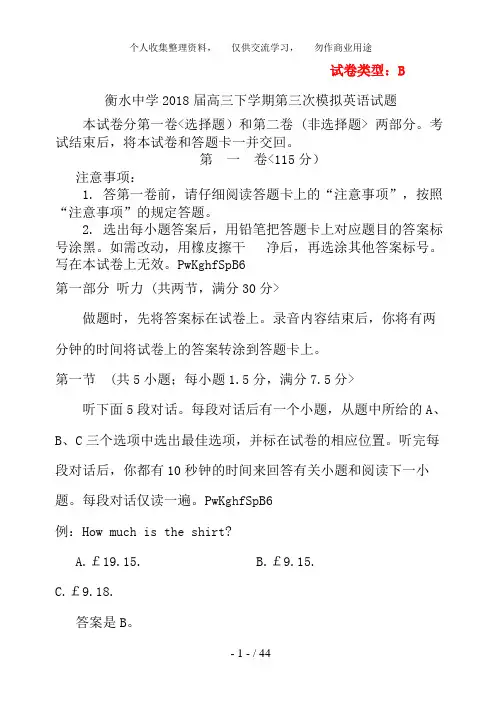
试卷类型:B 衡水中学2018届高三下学期第三次模拟英语试题本试卷分第一卷<选择题)和第二卷 (非选择题> 两部分。
考试结束后,将本试卷和答题卡一并交回。
第一卷<115分)注意事项:1. 答第一卷前,请仔细阅读答题卡上的“注意事项”,按照“注意事项”的规定答题。
2. 选出每小题答案后,用铅笔把答题卡上对应题目的答案标号涂黑。
如需改动,用橡皮擦干净后,再选涂其他答案标号。
写在本试卷上无效。
PwKghfSpB6第一部分听力 (共两节,满分30分>做题时,先将答案标在试卷上。
录音内容结束后,你将有两分钟的时间将试卷上的答案转涂到答题卡上。
第一节 (共5小题;每小题1.5分,满分7.5分>听下面5段对话。
每段对话后有一个小题,从题中所给的A、B、C三个选项中选出最佳选项,并标在试卷的相应位置。
听完每段对话后,你都有10秒钟的时间来回答有关小题和阅读下一小题。
每段对话仅读一遍。
PwKghfSpB6例:How much is the shirt?A.£19.15.B.£9.15.C.£9.18.答案是B。
1. Where does the conversation take place?A. In a classroom.B. In a restaurant.C. In a hospital.PwKghfSpB62. When will the man be able to visit Mr. Black?A. On November 1st.B. On November 2ndC. On November 3rd.PwKghfSpB63. What do we know from the man’s answer?A. He doesn’t like either.B. Brown is his favoritecolor. C. He likes both the two shirts.PwKghfSpB64. What does the man plan to do this afternoon?A. Go to a movie.B. Go to his classes.C. Go to buy something.PwKghfSpB65. What can we learn about Tom from theconversation?PwKghfSpB6A. He has got a fever.B. He has been practicing running for quite a longtime.PwKghfSpB6C. He has no idea where to see a doctor.第二节 <共15小题;每小题1.5分,满分22.5分)听下面5段对话或独白。
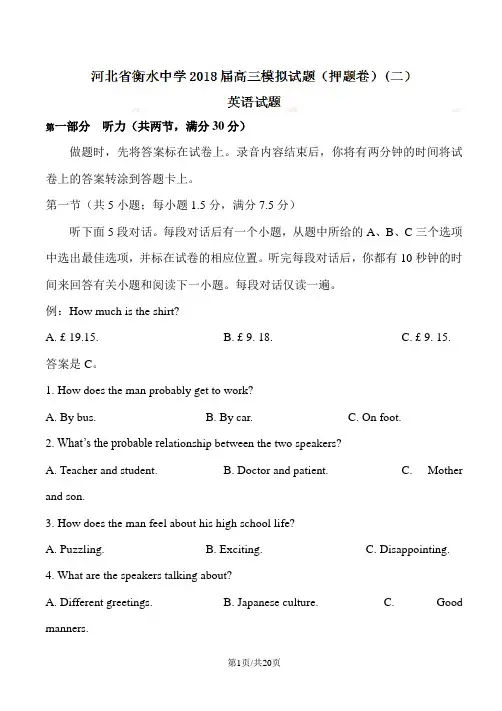
第一部分听力(共两节,满分30分)做题时,先将答案标在试卷上。
录音内容结束后,你将有两分钟的时间将试卷上的答案转涂到答题卡上。
第一节(共5小题;每小题1.5分,满分7.5分)听下面5段对话。
每段对话后有一个小题,从题中所给的A、B、C三个选项中选出最佳选项,并标在试卷的相应位置。
听完每段对话后,你都有10秒钟的时间来回答有关小题和阅读下一小题。
每段对话仅读一遍。
例:How much is the shirt?A. £ 19.15.B. £ 9. 18.C. £ 9. 15. 答案是C。
1. How does the man probably get to work?A. By bus.B. By car.C. On foot.2. What’s the probable rel ationship between the two speakers?A. Teacher and student.B. Doctor and patient.C. Mother and son.3. How does the man feel about his high school life?A. Puzzling.B. Exciting.C. Disappointing.4. What are the speakers talking about?A. Different greetings.B. Japanese culture.C. Good manners.5. What does the woman mean?A. She does n’t like the new manager.B. The new manager went to Shanghai.C. She hasn’t met the new manager yet.第二节(共15小题;每小题1.5分,满分22.5分)听下面5段对话或独白。
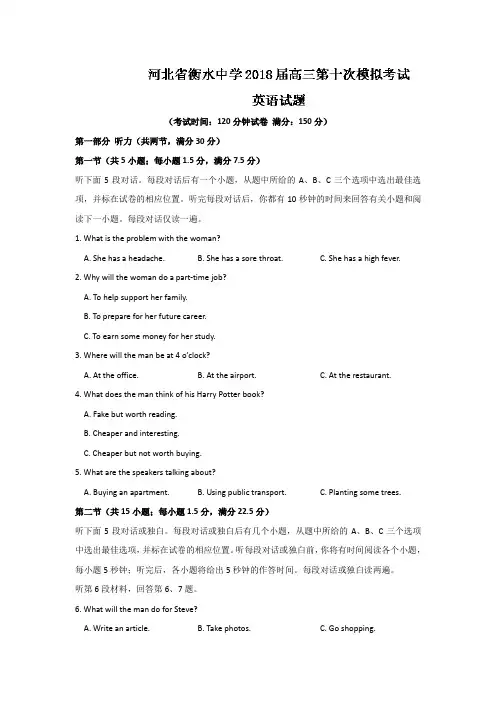
(考试时间:120分钟试卷满分:150分)第一部分听力(共两节,满分30分)第一节(共5小题;每小题1.5分,满分7.5分)听下面5段对话。
每段对话后有一个小题,从题中所给的A、B、C三个选项中选出最佳选项,并标在试卷的相应位置。
听完每段对话后,你都有10秒钟的时间来回答有关小题和阅读下一小题。
每段对话仅读一遍。
1. What is the problem with the woman?A. She has a headache.B. She has a sore throat.C. She has a high fever.2. Why will the woman do a part-time job?A. To help support her family.B. To prepare for her future career.C. To earn some money for her study.3. Where will the man be at 4 o’clock?A. At the office.B. At the airport.C. At the restaurant.4. What does the man think of his Harry Potter book?A. Fake but worth reading.B. Cheaper and interesting.C. Cheaper but not worth buying.5. What are the speakers talking about?A. Buying an apartment.B. Using public transport.C. Planting some trees.第二节(共15小题;每小题1.5分,满分22.5分)听下面5段对话或独白。
每段对话或独白后有几个小题,从题中所给的A、B、C三个选项中选出最佳选项,并标在试卷的相应位置。
试卷类型:A 衡水中学2018届高三下学期第三次模拟英语试题本试卷分第一卷<选择题)和第二卷 (非选择题> 两部分。
考试结束后,将本试卷和答题卡一并交回。
第一卷<115分)注意事项:1. 答第一卷前,请仔细阅读答题卡上的“注意事项”,按照“注意事项”的规定答题。
2. 选出每小题答案后,用铅笔把答题卡上对应题目的答案标号涂黑。
如需改动,用橡皮擦干净后,再选涂其他答案标号。
写在本试卷上无效。
ARbkCL11FO第一部分听力 (共两节,满分30分>做题时,先将答案标在试卷上。
录音内容结束后,你将有两分钟的时间将试卷上的答案转涂到答题卡上。
第一节 (共5小题;每小题1.5分,满分7.5分> 听下面5段对话。
每段对话后有一个小题,从题中所给的A、B、C三个选项中选出最佳选项,并标在试卷的相应位置。
听完每段对话后,你都有10秒钟的时间来回答有关小题和阅读下一小题。
每段对话仅读一遍。
ARbkCL11FO例:How much is the shirt?A.£19.15.B.£9.15.C.£9.18.答案是B。
1. Where does the conversation take place?A. In a hospital.B. In a restaurant.C. In a classroom.ARbkCL11FO2. When will the man be able to visit Mr. Black?A. On November 1st.B. On November 2ndC. On November 3rd.ARbkCL11FO3. What do we know from the man’s answer?A. He doesn’t like either.B. Brown is hisfavorite color. C. He likes both the twoshirts.ARbkCL11FO4. What does the man plan to do this afternoon?A. Go to a movie.B. Go to his classes.C. Go to buy something.ARbkCL11FO5. What can we learn about Tom from theconversation?ARbkCL11FOA. He has got a fever.B. He has been practicing running for quite a longtime.ARbkCL11FOC. He has no idea where to see a doctor.第二节 <共15小题;每小题1.5分,满分22.5分)听下面5段对话或独白。
河北省衡水中学2018届高三第十次模拟考试英语试题〔考试时间:120分钟试卷总分值:150分〕第一局部听力〔共两节,总分值30分〕第一节〔共5小题;每题1.5分,总分值7.5分〕听下面5段对话。
每段对话后有一个小题,从题中所给的A、B、C三个选项中选出最正确选项,并标在试卷的相应位置。
听完每段对话后,你都有10秒钟的时间来答复有关小题和阅读下一小题。
每段对话仅读一遍。
1. 音频What is the problem with the woman?A. She has a headache.B. She has a sore throat.C. She has a high fever.【答案】A【解析】此题为听力题,解析略。
2. 音频Why will the woman do a part-time job?A. To help support her family.B. To prepare for her future career.C. To earn some money for her study.【答案】B【解析】此题为听力题,解析略。
3. 音频Where will th e man be at 4 o’clock?A. At the office.B. At the airport.C. At the restaurant.【答案】A【解析】此题为听力题,解析略。
4. 音频What does the man think of his Harry Potter book?A. Fake but worth reading.B. Cheaper and interesting.C. Cheaper but not worth buying.【答案】C5. 音频What are the speakers talking about?A. Buying an apartment.B. Using public transport.C. Planting some trees.【答案】A【解析】此题为听力题,解析略。
河北省衡水中学2018届高三第十次模拟考试英语试题(考试时间:120分钟试卷满分:150分)第一部分听力(共两节,满分30分)第一节(共5小题;每小题1.5分,满分7.5分)听下面5段对话。
每段对话后有一个小题,从题中所给的A、B、C三个选项中选出最佳选项,并标在试卷的相应位置。
听完每段对话后,你都有10秒钟的时间来回答有关小题和阅读下一小题。
每段对话仅读一遍。
1.音频What is the problem with the woman?A. She has a headache.B. She has a sore throat.C. She has a high fever.【答案】A【解析】此题为听力题,解析略。
2.音频Why will the woman do a part-time job?A. To help support her family.B. To prepare for her future career.C. To earn some money for her study.【答案】B【解析】此题为听力题,解析略。
3.音频Where will the man b e at 4 o’clock?A. At the office.B. At the airport.C. At the restaurant.【答案】A【解析】此题为听力题,解析略。
4.音频What does the man think of his Harry Potter book?A. Fake but worth reading.B. Cheaper and interesting.C. Cheaper but not worth buying.【答案】C【解析】此题为听力题,解析略。
5.音频What are the speakers talking about?A. Buying an apartment.B. Using public transport.C. Planting some trees.【答案】A【解析】此题为听力题,解析略。
河北衡水中学2018届高三英语模拟试卷及答案河北衡水中学----- Excuse me, is the shop open around the clock?------- Only from 800 am to 400 pmA.I’m not sureB.Well, it dependsC.That’s rightD.I’m afraid not7 As beautiful movie about pain, struggle, hope and love, Slumdog Millionaire swept the ceremony with eight awards, including prize for best picturesA.a; theB.a; aC.the; aD.the; the8 ----I’d like to see the movie very much, but I have no money with me----That’s OK My _____this timeA offerB treatC promiseD service9 My parents ____ in Hengshui They were born there and have never lived anywhere elseA liveB livedC were livingD will live10 -----I don’t care what people think-----Well, you ____A couldB wouldC shouldD might11 reasonable, the idea he to create a friendly environment attracted much public attentionA.Sounded; came aboutB.Sounded; came acrossC.Sounding; came up withD.Sounding; came along12 Homuch _____ she looked without her glasses!A wellB goodC bestD better13 Please do me a favour---_______my friend Mr Smith to Youth Theatre at 730 tonightA to inviteB invitingC inviteD invited14I miss the teachers and the kindergarten _____ my parents think highly ofA whoB whereC whichD that15In no case go the laof nature or we’ll meet endless sufferingA.we can; byB.can we; forC.we can; roundD.can we, against 16______do the pubs stay open?A WhenB WhereC HoD Until when17The role change from husband to father, although difficult, doesn’t seem so great as from wife to mother A.one B.thatC.thisD.those18 “Hocould you lose so much money?” Charlie asked his wife, eyeing her angrily from the kitchen tableA.atB.acrossC.throughD.on19—Do you think it wise for Chinese parents to try to do everything for their children?—No, that’s they are mistakenA.whereB.whenC.whatD.howgrade class where I was substituting(代替)“I should never have let him go to the boy’s room without a pass! It was my fault he got into trouble with the hall monitor! I’m so stupid!”My friend burst out laughing, and then made her “Olympic” ment After a brief period of reflection I had to admit that she was right I did put myself down an awful lot Why, just during the previous day I had called myself “a slob” for having some papers spread out on my de sk, “ugly” when I left the house without makeup and “an idiot” when I left the house for an emergency substitute job without my emergency lesson planIn a more reflective tone, Annabel said, “I once took a workshop at church where the woman in charge had us list all the mean things we say about ourselves”“Homany did you have on your list?” I asked“Fifteen,” she confessed “But then the teacher said, ‘Noturn to the person next to you and say all the items on your list as if you were speaking to that person!’”My jadropped,“What did you do?”“Nothing Nobody did We all just sat there, until I said, ‘I could never say these things to anyone else!’”“And our teacher replied, ‘Well, if you can’t say them to anyone else, then don’t ever say them to yourself!’”My friend had a point I would never insult a child of God---and I’m God’s child, too!God, today let me be as kind to myself as I would be to another of Your children41 What does Annabel mean by the first sentence of the passage?A The writer is a good athleteB The writer scolds herself too muchC She is encouraging the writerD A gold medal is not a big deal42 What does the writer intends to tell us through the second and third paragraphs?A She has loself-esteem over some small thingsB She often makes serious mistakes in daily lifeC She is a third-grade teacherD She cares too much about her appearance43 We can infer that the underlined word “slob” might be_____A something untidyB someone dangerousC something dirtyD someone lazy44 What can we learn about Annabel?A She used to put herself down a lotB She often goes to churchC She was in charge of a workshopD She used to be too shy to talk to others45 What does the writer mean by the last sentence of the passage?A She is ready to turn to God for helpB She will be kind to all childrenC She won’t insult(侮辱) herself as well as othersD She is willing to be a child of GodBIf you are a male and you are reading this, congratulations you are a survivor According to statistics, you are more than twice as likely to die of skin cancer than a woman, and nine times more likely to die of AIDS Assuming you make it to the end of your natural term, about 78 years for men in Australia, you will die on average five years before a woman There are many reasons for this, men take more risks than women and are more likely to drink and smoke, but perhaps more importantly, men don’t go to the doctor“Men aren’t seeing doctors as often as they shoul d,” says Dr Gullotta, “This is particularly so for the over-40s, when diseases tend to strike” Gullotta says a healthy man should visit the doctor every year or two For those over 45,it should be at least once a yearAccording to a recent survey, 95%of women aged between 15 and early 40s see a doctor once a year, pared to 70% of men in the same age group“A lot of men thin k they are invincible (不可战胜的)”Gullotta says “They only e in when a friend drops dead on the golf course and they think ‘Dear me, if it could happen to him, …’ ”Then there is the ostrich (鸵鸟)approach, “Some men are scared of what might be there and would rather not know, ” says Dr Ross Cartmill“ Most men get their cars serviced more often than they service their bodies,” Cartmill says He believes most diseases that monly affect men could be addressed by preventive check-ups Regular check-ups for men would inevitably(不可避免地) place stress on the public purse Cartmill says “But prevention is cheaper in the long run than having to treat the diseases Besides, the final cost is far greater”46 Which is the most important reason why men die five years earlier on average than women according to the passage ?A Men drink and smoke much more than womenB Men aren’t as cautious as women in face of dangerC Men don’t seek medical care as often as womenD Men are more likely to suffer from fatal diseases47Which of the following best pletes the sentence “Dear me, if it could happen to him,…”in paragraph5 ?A I should avoid playing golfB I should consider myself luckyC it would be a big misfortuneD it could happen to me, too48 What does Dr Ross Cartmill mean by “the ostrich approach” in paragraph 6 ?A A netreatment for certain psychological problemsB Refusal to get medical treatment for fear of the pain involvedC Unwillingness to find out about one’s disease because of fearD A casual attitude towards one’s health conditions49 What does Cartmill say about regular check-ups for men?A They may increase public expensesB They will save money in the long runC They may cause psychological stress on menD They will enable men to live as long as womenCMy mother moved a lot when she was growing up on account of Grandpa being in the army.She hated having to adjust to neschools and make nefriends.That’s why I thought she was joking when she put forward the idea of moving.But she was pletely serious “F or just the two of us,” my mother said,“an apartment in the city will suit our needs much better.” Personally, I think she lost her mind.I guess I can understand why she would want to move,but what about me and what this house means to me?I suppose if you looked at my house,you might think it was just another country house.But to me it is anything but standard.I moved into this house with my parents ten years ago I can still remember that first day like it was yesterday.The first thing I noticed was the big front yard.To me it seemed like an ocean of grass—couldn’t wait to dive in.The backyardwas full of gnarled(扭曲的,粗糙的)and scary trees that talked on windy nights.But I greto like them and the shadows they cast in my room.My father and I even built a small tree house,where I often go to remember all the wonderful time we had before Father’s deathThis house is special—maybe only to me—but special nevertheless It’s the little seemingly insignificant things that make this house so special to me; the ice-cold tile floors that make me tremble on midnight snake runs; the smell of my fathers pipe that still exists; the towering bookcases of my mother; the vieoutside my bedroom windowThis house bears too many memories, memories which would be lost if we gave it up50.Why did the author’s mother decide to move?A.Because she hated the countryside.B.Because Grandpa was on constant move.C.Because Dad’s death made her lose her mind.D.Because she thought a city flat more fit for them.51.What impressed the author when she first moved into the house?A.The tree house B.The big trees C.The cold floorsD.The green grass52.Hodid the author let us feel that the house was special to her?A.By arguing whether the house was standardB.By explaining why the house suited their needsC.By describing the small things related to her house. D.By paring the differences between country and city life.53.The author describes the house with .A.love B.responsibility C.promise D.enthusiasmDCOPENHAGEN—The world is gathered in Copenhagen for the UN climate summit, but Denmark’s bicycle-friendly capital has also given its name to a movement of cities trying to find a kinder way to mute(往返上下班)Nearly 40 percent of Copenhagen’s population cycle to work or school on ubiquitous(无处不在的) paved cycle paths Many residents take to their bikes year-round, braving rain and snothrough the winter in a city where the bicycles outnumber the peopleAmsterdam and Beijing too are known for their bicycles, but the Danish capital is where urban planners from around the world have been looking for ways to get their people out of cars and up onto bikes, an effort known as Copenhagenisation Klaus Bondam, Copenhagen’s technical and environmental chief, calls himself a “mega cyclist” and says the bike’s popularity stems partly from high taxes on cars which meant working-class Danes could not afford to drive in the 1930s and 40s “Today you’ll meet everybody on the bicycle lanes --- women and men, rich and poor, old and young,” Bondam s aid The local government has during the last three years invested more than 250 million crowns ($4942 million) in bicycle lanes and to make the traffic safer for bicyclists Today around a third of the population drive cars to work or study, another third take public transport, while 37 percent cycle -- a figure the city aims to boost to 50 percent by thirds of people in Copenhagen cycle to work or schoolD.city planners try their best to encourage more citizensto ride bikes56.Bikes are popular in Copenhagen partly because __________A.the citizens are unable to afford to buy a carB.the rich tend to keep fit by cycling to workC.young people regard cycling a fashion to followD.high taxes were paid for cars in the 1930s and 40s 57.Which of the following is NOT the benefit of cycling?A.Saving time on the road B.Declining pollution and noise C.Improving public health D.Creating safety in the city EThat little “a” with a circle curling around it that is found in E – mail addresses is most monly referred to as the “at” symbolSurprisingly though, there is no official, universal name for this sign There are dozens of strange terms to describe the “@” symbolBefore it became the standard symbol for electronic mail, the “@” symbol was used to represent the cost of something or hoheavy something is For instance, if you purchased 6 apples, you might write it as 6 apples “@” $110 eachWith the introduction of e-mail came the popularity of the “@” symbol The “@” symbol or the “at sign” separates a person’s online user name from his mail server(服务器) address For instance, joe@uselessknowledge Its widespread use on the Inter made it necessary to put this symbol on keyboards in other countries that have never seen or used the symbol before As a result, there is really no official name for this symbol The actual origin of the symbol remains a mystery Historytells us that the @ symbol came from the tired hands of the Middle Ages During the Middle Ages before the invention of printing machines, every letter of a word had to be copied with great efforts by hand for each copy of a published book The monks that performed these long, boring coping duties looked for ways to reduce the number of individual strokes (笔画) per word for mon words Although the word “at” is quite short to begin with, it was a mon enough word in text and documents so that those monks thought it would be quicker and easier to shorten the word “at” even more As a result, the monks changed the shape of “t” into a circle to surround “a”, thus leaving out two strokes in the spelling “t”58.Which of the following is the best title of the passage?A.Ho“at” developed into @B.Ho@ came into beingC.Homonks invented @D.Hopeople wrote the cost of something 59.Which is NOT the reason for the monks to spell “at” as @?A.Though “at” is short, it was used very oftenB.The monks wanted to be quicker and easier with their copyingC.The monks wanted to invent a neordD.Copying work was long and boring for them60.According to paragraph 5, which is TRUE about the symbol of @ today?A.When you are online, you must use the @ symbolB.Kittly 163@is an email addressC.In countries where @ is used, governments have given it an official nameD.It is likely to find the @ symbol on puter keyboardsworldwide第二节根据对话内容,从对话后的选项中选出能填入空白处的最佳选项。
2018届衡水中学高三十六次模拟考试英语试卷第一卷(选择题共100分)第一部分:听力(共两节,满分30分)第一节(共5小题;每小题1. 5分,满分7. 5分)听下面5段对话。
每段对话后有一个小题,从题中所给的A、B、C三个选项中选出最佧透項。
并标在试卷的相应位置。
听完每段对话后,你都有10秒钟的时间来回答有关小题和阅读下一小题。
每段对话仅读一遍。
1. What is the woman good at?A. SingingB. Playing the piano.C. Playing the drums.2Why is the man late?A Because of the heavy traffic.B. Because of the bad weather,C Because of the basketball match.3. What will the woman probably do?A. Charge her phone.B. L. cave the house.C. Call her mother.4. What are the two speakers talking about?A. A souvenir.B. A place.C. A piece of cloth.5. How much will the woman pay to rent the car?A200 dollars. B. 210 dollars. C. 240dollars.第二节(共15小题;每小题15分,满分22. 5分)听下面5段对话或独白。
每段对话或独自后有几个小题,从题中所给的A、B. C三个选項中选出最佳选项。
并标在试题的相应位置。
听每段对话成独白前,你都有时间阅读各个小题,每小题5秒钟:听完后。
各小题将给出5秒钟的作答时间。
每段对话或独白读两遍。
听第6段材料。
回答第6、7题。
6. What does the man want to do?A. Pay taxes.B. Get information.C. Answer questions.7. What does the woman advise the man to do?A. Call back later.B. Send an e-mail.C. Speak to someone else.。
(考试时间:120分钟试卷满分:150分)第一部分听力(共两节,满分30分)第一节(共5小题;每小题1.5分,满分7.5分)听下面5段对话。
每段对话后有一个小题,从题中所给的A、B、C三个选项中选出最佳选项,并标在试卷的相应位置。
听完每段对话后,你都有10秒钟的时间来回答有关小题和阅读下一小题。
每段对话仅读一遍。
C三个选项中选出最佳选项,并标在试卷的相应位置。
听每段对话或独白前,你将有时间阅读各个小题,每小题5秒钟;听完后,各小题将给出5秒钟的作答时间。
每段对话或独白读两遍。
听第6段材料,回答第6、7题。
6.WhatwillthemandoforSteve?A.Writeanarticle.B.Takephotos.C.Goshopping.7.Whenwillthespeakersmeet?A.OnFriday.B.Atnoon.C.Inthemorning.听第7段材料,回答第8、9题。
8.Whatmakesthewomanupset?A.Economicstress.B.Lossofhercreditcard.C.Presentforherfriends.9.Whatcausesthewoman’stroubleaccordingtotheman?A.Herattitudetolife.A.Shewasfined.B.Shegotinjured.C.Shehadanaccident.15.Wherewasthewitness?A.Outsidethepub.B.Atabusstop.C.Inhiscar.16.Whatwastheoldladydoinginthemiddleoftheroad?A.Lookingforsomething.B.Strugglingtostandup.C.Tryingtoseekhelp.听第10段材料,回答第17-20题。
17.WhendidAlfredNobeldie?A.In1906.B.In1901.C.In1896.18.WhichprizeisonlyaNoblePrizeinname?A.TheNobelPeacePrize.AwesomeActivities:CampsDatesandDetailsHowmuchdoesthiscampcost?Campmusthaveaminimumofsixcampersfortheprogramtorun.Noguarantees.Youwillrece iveafullrefundforanycancelledcamps.CALLUSAT916-278-6321FORMOREINFORMATIONANDTORESERVEYOURYOUTHCAMPSPOTTODAY.21.Whatwilllearnatthecamp?A.Holdingyourfootprints.B.Huntingforsmallanimals.C.Adventuringintheforest.D.Playinggamesintheriver.22.Ifyouarelatetofetchyourkidtwiceaweek,youhavetopay________.A.$155B.$310C.$145D.$30023.Whatmustyoubringtojointhecamp?A.AT-shirtandasweatshirt.B.Tennisshoesandwatershoes.C.Aswimsuitandatowel.D.Sunscreenandsunglasses.tlyattheentranceofthe café,MissHigashikokubarusaid:“IheardaboutthisplaceviaTwit terandIliketheideaofcominghere.Iworkasanurseand it’s alwaysverybusy.Therearevery fewquietplacesinTokyo,andit’sabigbusycity.Ijustwanttocomeandsitsomewherequietl yonmyown.I’mgoingtodrinkacupofteaandmaybedosomedrawings.Iliketheideaofaquiet,c almatmosphere.”ThedesiretobeisolatedisnotanewconceptinJapan,hometoanestimated3.6million“h ikikomori”–amoreextremeexampleofsocialrecluses(隐士)whowithdrawcompletelyfromsociety.24.Whatisspecialaboutthe“silent café”?A.Itprovidesvariousteaandbooks.B.Peoplearenotallowedtocommunicate.C.Ithasattractedmanypopularyoungpeople.D.Itoffersservicebywritingnotbyspeaking.25.WhichofthefollowingaccountsfortheideaofbeingaloneinJapan?ergameshouldbefrowned(皱眉)uponbytheirchildrenandgrandchildren?Nowadaysolderpeoplehavemorecontrolovertheirlivesandtheyplayafullpartinsocie ty.Moreover,betterhealthcarehasleftmorepeopleintheirsixtiesandseventiesfeelingf itandactiveafterretirement.Mentalactivity,aswellasphysicalexercise,cancontribut etobetterhealth.Playingcomputergamesisaveryeffectivewayofexercisingthebrain.Whenpersonalcomputerswerefirstintroduced,mostolderpeopledidn’tbelievetheyw ouldeverfamiliarizethemselveswithit.Nowcomputershavebeenaroundforafewgenerationsandretiredpeoplehavegraduallybecomemorerelaxedaboutusingthemforfun.Gamersover6 5preferplayingpuzzlegamesandcardgames.KateStevens,aged72,says:“Ifinditveryrela xing.It’snotverydemanding,butyoustillneedtoconcentrate.”Anotherdevelopmentthathasfavored“greygames”isa changeinthetypeofvideogames availableonthemarket.There’sagreatervarietyofgamestochoosefrom,includingmorein tellectualandcomplexstrategy(策略)andsimulation(模拟)games.InternetChessandTrainSimulatorareamongthemostpopularofthese.TrainSimulato30.ThemethodtheauthorusestodevelopParagraph4is________.A.offeringanalysesB.givingexamplesC.makingcomparisonsD.providingdetails31.Bysaying“Thiscouldn’tbefurtherfromthetruth.”inParagraph5,theauthormeans__ ______.A.mindchallenginggamesarenotsuitableforolderpeopleB.childrenshouldimprovetheirskillswithpracticeC.playingcomputergamesrequiresanalyticalthinkingD.olderpeoplecanperformwellinsomecomputergamesDInthemid-2000s,WazeMobileco-founderEhudShabtaireceivedacutting-edge(尖端的)giftfromhisgirlfriend:aGPS.Theexpensivegiftwassupposedtobehelpful.Butstraightou tofthebox,itwasalreadyoutofdate.Shabtai,acodingenthusiast,hadanimmediatereactiontoreinvent.Shabtai’ssolutindanytime.WazeCarpoolisgoingstraighttotheheartoftrafficjams,tryingtogetmoredriversoff theroadandintocarpools.Theapphasalreadyconnectedtensofthousandsofrideseekerswit hdriverswillingtoferrythemalongasharedroute,andthattrendcouldbetheanswertoatraf fic-freefuture.32.WhatdidShabtaidowhenhefoundhisgirlfriend’sgiftoutofdate?A.Heimprovedit.B.Hetookitapart.C.Heputitaway.D.Heuseditanyway.33.WhatsetsWazeMobileapartfromtraditionalnavigationapps?A.Ithasthemostusers.B.Itcanindicatedirections.C.Itreportsroadconditionsinrealtime.D.Mostusershelpedititswords.34.Whatdoestheunderlinedwordinparagraph6probablymean?pportunities.Sadly,inundertowmonthsthecompanydownsized,andKathrynlostherjob.She remembers,“___38___”Mayasaysthedifficultiesbroughtthemcloser,andshepraisesher mom.“She’smorethanateammate.Iknowshe’sgoingtobeonmyside.”Aboutayearlater,motheranddaughtermovedtoGeorgia,whereMayacontinuedtoplaybas ketball.Inhighschoolshehadtheopportunitytoplaybasketballagainstsomeofthenation ’sbestplayers.___39___Mayaledherteamto125victoriesandthreestatechampionships.D uringthistime,shewasnamedthenationalplayeroftheyeartwice.___40___Mayaandhermotherapproachedthecollegedecisionliketheydideverything.W ithcarefulconsideration,MayachosetheUniversityofConnecticut.A.Itwasabadtime.B.Itreallyacompetitiveskill.C.Thecompetitionimprovedherskills.D.Youcan’tsucceedwithouttoomuchpayment.Buteven47thesefacts,myfirstinstinct(本能反应)wastoshowherwithsome48:“Oh,nohoney.You’regoodatsports!Youjusthavetokeep49!”B utIdecidedtotellherthe50,andIcouldseeithurtabit.SoIsaidmore:“Ava,weallhavethingsweareparticularly,51goodat.Likeyouand52.Yo u’reinthe5thgradeandreadCharlesDickens.Thatisn’t53,butyou’vedoneitwithouteve ntrying.Butallofusalsohavethingsthatweare54in.Ifwewantogetgoodatthosethings,weh avetoputintwicethe55ofthepeoplearoundustogettoadecent(相当的)pointandevenharderifwewantto56.”Shewasnodding.Shetotally57it.Why?Becauseit’sthetruth.SometimesIwonderwhywe runaroundtalkingnonsense(胡扯)toourkidswhentheycan58thetruth.Andtheycansmellrubbishfromamileaway.Inotherwords ,theycaneasilyrecognizeyouare59.Inaddition,iftheydon’tknowwherethey60now,they ’llneverknowhowtogetsomewherenew.58.A.hide B.avoid C.learn D.handle59.A.joking B.lying C.struggling D.regretting60.A.fall B.live C.stop D.stand第二节(共10小题;每小题1.5分,满分15分)阅读下面短文,在空白处填入1个适当的单词或括号内单词的正确形式。
衡水中学高考押题英语试题(有答案)第一部分听力(共两节,满分30分)做题时,先将答案标在试卷上。
录音内容结束后,你将有两分钟的时间将试卷上的答案转涂到答题卡上。
第一节(共5小题;每小题1. 5分, 满分7. 5分)听下面5段对话。
每段对话后有一个小题,从题中所给的A、B、C三个选项中选出最佳选项,并标在试卷的相应位置。
听完每段对话后,你都有10秒钟的时间来回答有关小题和阅读下一小题。
每段对话仅读一遍。
例:How much is the shirt?A. £19. 15.B. £9. 15.C. £9. 18.答案是C。
1. Which sport does Jane like best?A. Basketball.B. Volleyball.C. Tennis.2. What will the woman do?A. Deliver the man’s baby.B. Attend the man’s wife.C. Take care of the man’s dog.3. What did the man do?A. He played in the park.B. He removed the rubbish.C. He fixed the shower.4. When will the woman probably arrive at Beijing Hotel?A. 11:30.B. 11:50.C. 11:20.5. What are the two speakers mainly talking about?A. What to buy as birthday gifts.B. Whether to hold a birthday party.C. Where to spend the weekend.第二节(共I5小题;每小题1. 5分,满分22. 5 分)请听下面5段对话或独白。
每段对话或独白后有几个小题,从题中所给的A、B、C三个选项中选出最佳选项,并标在试卷的相应位置。
听每段对话或独白前,你将有时间阅读各个小题,每小题5秒钟;听完后,各小题将给出5秒钟的作答时间。
每段对话或独白读两遍。
听第6段材料,回答第6至7题。
6. Who did the woman babysit before?A. Her cousin.B. The man’s daughter.C. Her cousin’s daughter.7. What’s the man doing?A. Interviewing the woman.B. Discussing with the woman.C. Training the woman.听第7段材料,回答第8至9题。
8. How often do the buses run?A. Every 5 minutes.B. Every 9 minutes.C. Every 15 minutes.9. What makes the woman confused?A. The life style.B. The way people talk.C. The weather.听第8段材料,回答第10至12题。
10. What is the relationship between the two speakers?A. A couple.B. Business partners.C. Mother and son.11. What does the man have to do by Friday?A. Organize the meeting room.B. Come up with a marketing plan.C. Sign a contract with the sales department.12. What does the woman think of the man’s boss?A. Helpful.B. Hard-working.C. Cruel.听第9段材料,回答第13至16题。
13. Who gave the speech about Physical Geography?A. Mark Lowcock.B. Heather Nauert.C. Henry Hadley.14. What did the man do after leaving the lecture hall?A. He visited a professor.B. He went to the library.C. He played video games.15. How many lectures did the woman listen to yesterday afternoon?A. 1.B. 3.C. 4.16. How does the woman think of the following speeches?A. Long and boring.B. Interesting and useful.C. Long but understandable. 听第10段独白,回答第17至20题。
17. What was Ashley doing when her daughter was lost?A. Eating lunch.B. Playing a game.C. Looking at a map.18. How old is Betty?A. 3.B. 5.C. 7.19. What is Betty wearing?A. A red jacket and a pair of white shoes.B. A blue jacket and a white pant.C. A blue pant and a pair of red sneakers.20. Which number should be called if somebody has the information about the girl?A. 430513628.B. 430513682.C. 435013628.第二部分阅读理解(共两节,满分40分)第一节(共15小题;每小题2分,满分30分)阅读下列短文,从每题所给的A、B、C和D四个选项中,选出最佳选项。
AFall in Love With Your Writing With These Books!Write NakedBy Jennifer ProbstWAS: $16.99NOW: $15.99Bestselling author Jennifer Probst reveals her pathway to success, from struggling as a new writer to signing a seven-figure deal. Written in Probst’s unmistakable and honest voice, Write Naked mixes personal essays on craft with down-to-earth advice on writing romance in the digital age.Just WriteBy James Scott BeliWAS: $17.99NOW: $10.99Write yourself past fears, doubts and setbacks, using your desire writing excellence to deeply involve yourself in the craft. In Just Write, you’ll learn how to master the nuances(细微差别) of fiction, discover what readers really want, and persevere through the challenges of getting started, conquering writers block and dealing with rejection.Damn Fine StoryBy Chuck WendigWAS: $17.99NOW: $8.99Great storytelling is making readers care about your characters. And to tell a damn fine story, you need to understand why and how that caring happens. Using a mix of personal stories, pop fiction examples and traditional storytelling terms, The New York Times bestselling author Chuck Wendig will help you internalize the feel of powerful storytelling,Fearless WritingBy William KenowerWAS: $16.99NOW:$15.99Filled with insightful wisdom and practical advice, Fearless Writing teaches you how to accept the inner value of your work, enter a flow state while writing and overcome rejection, delay and other obstacles that prevent your creativity. With Fearless Writing, you’ll find the inner strength to set on a brave journey and build a lifelong career in the process.21. Who shares his/her own writing experience with the readers?A. Jennifer Probst.B. James Scott Beli.C. Chuck Wendig.D. William Kenower.22. Which book has the highest discount?A. Write Naked.B. Just Write.C. Damn Fine Story.D. Fearless Writing.23. What do the four books have in common?A. They are written by bestselling authors.B. They focus on traditional storytelling terms.C. They show how to overcome rejection.D. They give some practical advice on writingBThe year 2117 will be an eventful one for art. In May of that year in Berlin, the philosopher-artist Jonathon Keats’ “century cameras”—cameras with a 100-year-long exposure (曝光)time—will be brought back from hiding places around the city to have their results developed and exhibited. Six months after that, the Future Library in Oslo, Norway, will open its doors for the first time, presenting 100 books printed on the wood of trees planted in the distant past of 2017.As Katie Paterson, the creator of the Future Library, puts it: “Future Library is an artwork for future generations.” These projects, more than a century in the making, are part of a new wave of slow art intended t o push viewers and Participants to think beyond their own lifetimes. They aim to challenge today’s short-term thinking and the brief attention spans of modern consumers, forcing people into considering works more deliberately. In their way, too, they are fighting against modern culture—not just regarding money, but also the way in which artistic worth is measured by attention.In a similar fashion, every April on Slow Art Day, visitors are encouraged to stare at five works of art for 10 minutes at a time—a tough task for the average museum visitor, who typically spends less than30seconds on each piece of art.Like the Future Library, the century cameras are very much a project for cities, since it’s in cities that time runs fastest and the pace of life is fastest. “Since I started living in a city, I’ve somehow been quite disconnected,” Anne Beate Hovind, the Future Library project manager, who described how working on the library drew her back to the Pace of life she knew when she was growing up on a farm in her youth, told The Atlantic magazine.24. According to the first paragraph, what will NOT happenin2117?A. A camera which was produced 100 years ago will be exhibited.B. The Future Library will be0pen to the public for the first time.C. Photos with a 100-year exposure time will be developed and exhibited.D. Books printed on the wood of trees planted in 2017 will be displayed.25. What can we learn about today’s people’s attitude toward works of art?A. They consider works deliberately.B. They spend little time on Works.C. They spend much money 0n works.D. They stare at works for 10 minutes at a time.26. What is the purpose of the wave of slow art?A. To advocate creating works of art slowly.B. To protect works of art from being damaged.C. To promote works of art for modern culture.D. To encourage people to pay more attention to works of art.27. How would Anne Beate Hovind feel about the city life?A. It’s discouragingB. It’s dullC. Its developed.D. It’s busyCScientists have b een studying how people use money for long. Now they’re finding some theories may apply to one group of monkeys.Researchers recently taught six monkeys how to use money. They gave the monkeys small metal disks(圆片) that could be used like cash and showed them some yummy apple pieces. The monkeys soon figured out that if they gave one of the disks to a scientist, they d receive a piece of apple in return.If you think that is all the monkeys can figure out, you are wrong. Two researchers, Jake and Allison, acted as apple sellers in the experiments. The monkeys were tested one at a time and had 12 disks to spend in each experiment. Jake always showed the monkeys one apple piece, while Allison always showed two piec es. But that’s not necessarily what they gave the monkeys. The number of apple pieces given for a disk was determined at random.Experiment One: Allison showed two pieces of apples but gave both pieces only half the time. The other half, she took one piece away and gave the monkey just the remaining piece. Jake, on the other hand, always gave exactly what he showed: one piece for each disk. The monkeys chose to trade more with Allison.Experiment Two: Allison continued to sometimes gave two pieces and sometimes one piece. But now, half the time, Jake gave the one apple piece he was showing, and half the time he added a bonus. Guess what? The monkeys chose to trade more with Jake.In the first experiment, the monkeys correctly figured out that if they trad ed with Allison, they’d end up with more treats. In the second one, when a monkey received two pieces from Jake, it seemed like again. When Allison gave the monkey only one piece instead of the two she showed, it seemed like a loss. The monkeys preferred trading with Jake because they’d rather take a chance of seeming to win than seeming to lose.We also sometimes make silly business decisions just to avoid the feeling that we’re getting less, even when were not. Would you have made the same choices?28. What conclusion might experts draw from the first experiment?A. The monkeys show certain business sense.B. Business theories can apply to all monkeys.C. People are smarter in terms of finance.D. It’s easy to teach monkeys how to trade.29. What does a bonus in paragraph 5 refer to?A. A metal disk.B. An apple piece.C. A chance.D. A coin.30. Why did the monkeys choose to trade more with Jake in the second experiment?A. Because Jake always gave them two apple pieces.B. Because the apple pieces from Jake were yummy.C. Because they didn’t like the feeling of losing.D. Because they get more apple pieces from Jake.31. What could be the best title for the passage?A. People’s Business Decision: Lose or Gain?B. Moneky’s Business Sense: Smart or Silly?C. Shopping for Bargain: Same or different?D. Disk for Apple: Who to Trade with?DScience is finally beginning to embrace animals who were, for a long time, considered second-class citizens.As Annie Potts of Canterbury University has noted, chickens distinguish among one hundred chicken faces and recognize familiar individuals even after months of separation. When given problems to solve, they reason: hens trained to pick colored buttons sometimes choose to give up an immediate food reward for a slightly later (and better) one. Healthy hens may aid friends, and mourn when those friend die.Pigs respond meaningful to human symbols. When a research team led by Candace Croney at Penn State University carried wooden blocks marked with X and O symbols around pigs, only the O carriers offered food to the animals. The pigs soon ignored the X carriers in favor of the O’s. Then the team switched from real-life objects to T-shirts printed with X or O symbols. Still, the pigs walked only toward the O-shirted people: they had transferredtheir knowledge to a two-dimensional format, a not inconsiderable feat of reasoning.I’ve been guilty of prejudiced expectations, myself. At the start of my career almost four decades ago, I was firmly convinced that monkeys and apes out-think and out-feel other animals. They’re other primates(灵长目动物), after all, animals from our own mammalian(灵长目动物) class. Fairly soon, I came to see that along with our closest living relatives, whales too are masters of cultural learning. and elephants express profound joy and mourning with their social companions. Long-term studies in the wild on these mammals helped to fuel a viewpoint shift in our society: the public no longer so easily accepts monkeys made to undergo painful procedure in laboratories, elephants forced to perform in circuses, and dolphins kept in small tanks at theme parks.Over time, though, as I began to broaden out even further and explore the inner lives of fish, chickens, pigs, goats, and cows, 1 started to wonder: Will the new science of "food animals" bring an ethical (伦理的) revolution in terms of who we eat? In other words, will our ethics start to catch up with the development of our science?Animal activists are already there, of course, committed to not eating these animals. But what about the rest of us? Can paying attention to the thinking and feeling of these animals lead us to make changes in who we eat?32. According to Annie Potts, hens have the ability of .A. interactionB. analysisC. creationD. abstraction33. The research into pigs shows that pigs .A. learn letters quicklyB. have a good eyesightC. can build up a good relationshipD. can apply knowledge to new situations34. Paragraph 4 is mainly about .A. the similarities between mammals and humansB. the necessity of long-term studies on mammalsC. a change in people’s attitudes towards animalsD. a discovery of how animals express themselves35. What might be the best title for the passage?A. The Inner Lives of Food AnimalsB. The Lifestyles of Food AnimalsC. Science Reports on Food AnimalsD. A Revolution in Food Animals第二节(共5小题;每小题2分,满分10分)根据短文内容,从短文后的选项中选出能填入空白处的最佳选项。